Advantage Campaign BudgetAdvantage Campaign Budget (formerly Campaign Budget Optimization) automatically manages your Facebook campaign budget across ad sets to get you the overall best results. More (formerly Campaign Budget Optimization or CBO) is an option when you create a Meta ads campaignThe campaign is the foundation of your Facebook ad. This is where you'll set an advertising objective, which defines what you want your ad to achieve. More. Should you turn it on?

In this post, we’ll explore:
- How Advantage Campaign BudgetA budget is an amount you're willing to spend on your Facebook campaigns or ad sets on a daily or lifetime basis. More works
- Eligibility requirements
- How to set it up
- Ad set spend limits
- Best practices
- When you should use it
There’s lots to cover here. Let’s go…
How it Works
The standard campaign setup utilizes individual ad set budgets. Let’s assume that you have three ad sets…
- Ad Set 1: $20
- Ad Set 2: $20
- Ad Set 3: $20
Each ad set has its own budget.
But when Advantage Campaign Budget is turned on, the budget is set within the campaign. If it’s turned on for the example above, your campaign budget might be $60. Meta can then distribute your budget optimally to get you the best results.
This simplifies the process of determining how much you should budget for each ad set. Instead of forcing the algorithm to spend $20 per ad set, Advantage Campaign Budget may distribute it on a particular day like this:
- Ad Set 1: $30
- Ad Set 2: $10
- Ad Set 3: $20
If Ad Set 2 isn’t performing well, Meta can spend less on that ad set; if Ad Set 1 is outperforming the others, more budget can be moved to it. This is also a fluid process. The amount of budget dedicated to each ad set can change on a day-to-day basis.
Eligibility Requirements
In order to use Advantage Campaign Budget, the following will be true:
1. There are at least two ad setsAn ad set is a Facebook ads grouping where settings like targeting, scheduling, optimization, and placement are determined. More within the campaign.
2. The same budget type will be utilized for all ad sets (daily or lifetime).
3. A common bid strategyWhen you enter an ad into the auction, Meta will bid for you. But in some cases, it may benefit you to adjust the bidding strategy to get better results. Options include Highest Volume, Cost Per Result Goal, Highest Value, ROAS Goal, and Bid Cap. More will be utilized across all ad sets.
4. If using the Highest Volume bid strategyThe default bid strategy for most objectives. Meta will attempt to get you the highest volume of optimized actions within your budget. No concern will be given to value, ROAS, or cost per action. More, the same optimization event (Performance GoalThe Performance Goal is chosen within the ad set and determines optimization and delivery. How you optimize impacts who sees your ad. Meta will show your ad to people most likely to perform your desired action. More) will be utilized across all ad sets.
5. Standard delivery will automatically apply.
If you want to create ad sets that differ by budget type, bid strategy, performance goal, or delivery, you’ll need to utilize ad set budgets.
How to Set it Up
Once you turn on Advantage Campaign Budget, it will look like this…
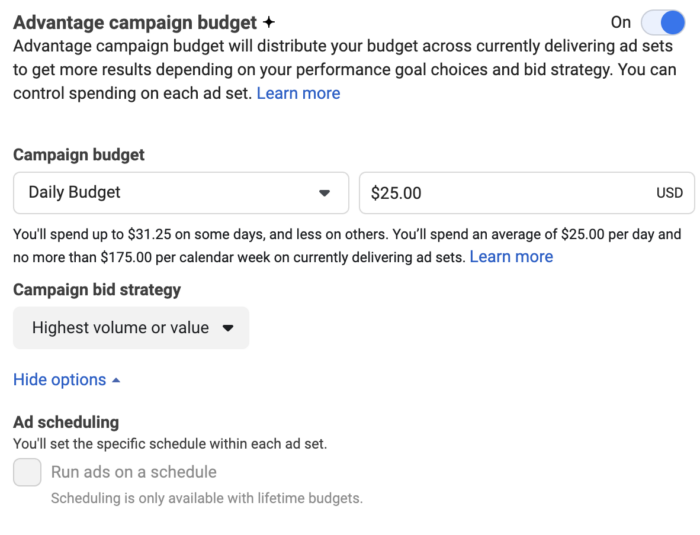
You can set either a daily or lifetime budgetAdvertisers have the option of setting a daily or lifetime budget. A lifetime budget lets you set a spending limit for the lifetime of an ad set. Meta will attempt to evenly spread the amount you spend across the dates that you've selected. More. Just remember that this budget applies to all of the ad sets within the campaign. So, if you’d typically use three $20 ad set budgets, you’ll likely want to use a $60 budget here.

If you use a lifetime budget, you can run ads on a schedule (dayparting).
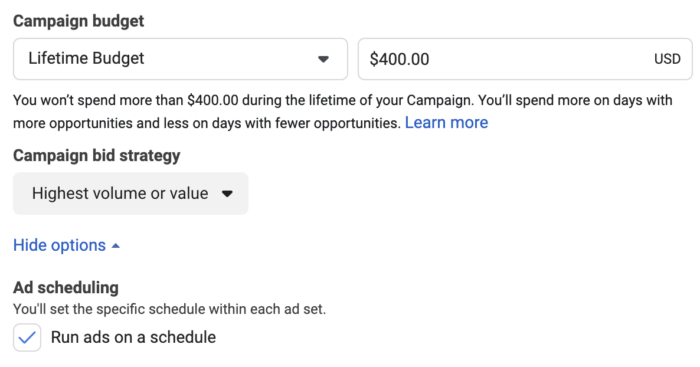
The schedule will be set within the ad set, so you can customize this by ad set.
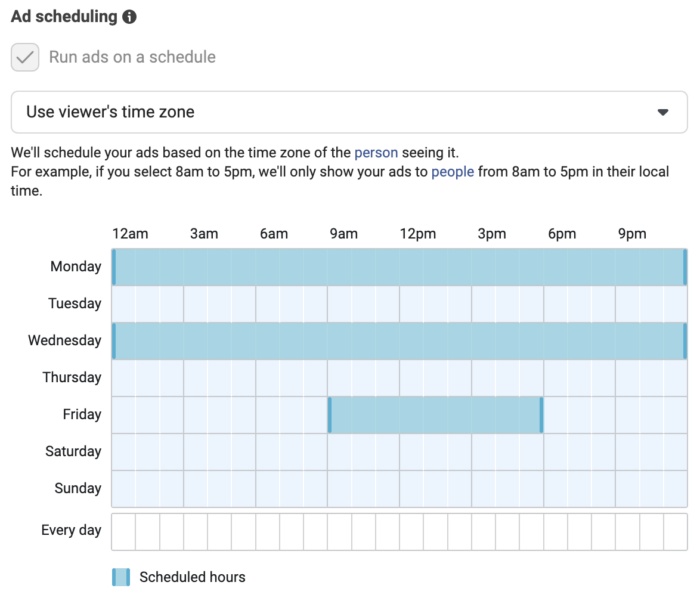
The bid strategy that applies to all ad sets is determined within the campaign.
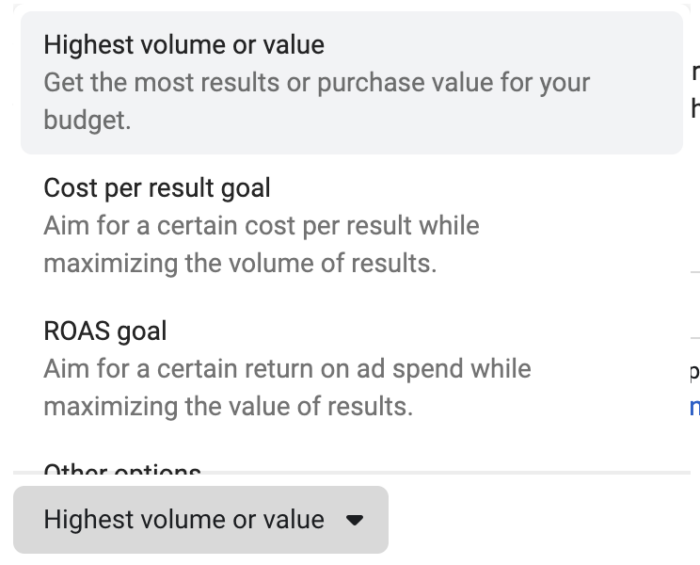
Depending on the objectiveWhen you create a campaign, one of the first things you'll do is select an objective. The campaign objective is your ultimate goal. Your selection will impact options, including optimization and delivery. Options include Awareness, Traffic, Engagement, Leads, App Promotion, and Sales. More, you will have the typical options available:
- Highest Volume or Value (Value if this is your Performance Goal for a Sales campaign)
- Cost Per Result GoalWhen using the Highest Volume bid strategy, advertisers can choose to set a Cost Per Result Goal. This allows to establish how much you're willing to pay for the optimized action. It's not a hard cap, but a goal the algorithm will consider. More
- ROAS GoalWhen utilizing the Sales objective, "Maximize value of conversions," and Highest Value bid type, you can set a ROAS Goal. Meta will then attempt to spend your budget with a focus on maintaining your desired ROAS. More (if Value is your Performance Goal)
- Bid CapBid Cap is one of Facebook’s bid strategy options, which guides Meta on how to bid in the ad auction. A Bid Cap sets a maximum bid across auctions, rather than allow them to bid dynamically. More
None of these settings are unique to Advantage Campaign Budget. So if you wouldn’t normally use them when using ad set budgets, don’t worry about it.
Ad Set Spend Limits
Maybe you are required to spend a certain amount on an audienceThis is the group of people who can potentially see your ads. You help influence this by adjusting age, gender, location, detailed targeting (interests and behaviors), custom audiences, and more. More or you want to prevent Meta from pushing too much of the budget to one ad set. You can control this with ad set spend limit minimums and maximums.
After you turn Advantage Campaign Budget on, check the box for ad set spend limits within Budget & Schedule in the ad set. This is available regardless of whether you use daily or lifetime budgets.
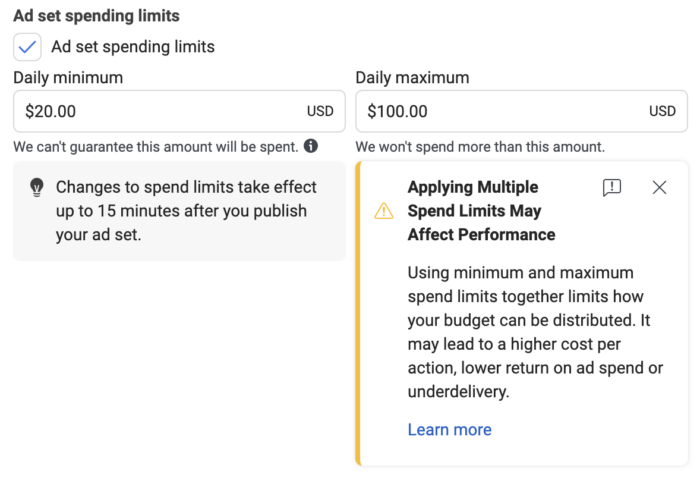
As you can see in the graphic above, Meta can’t guarantee that your minimum will be met, but it will attempt to spend it.

And the warning makes it clear that it is not recommended that you apply both a minimum and maximum ad set spend limit as it will restrict the algorithm.
There is a deeper philosophical discussion to be had regarding ad set spend limits that we’ll need to cover in another post. But overall, I don’t recommend using them. In fact, even Meta doesn’t recommend using them.

If you don’t trust Meta to optimally distribute your budget using Advantage Campaign Budget, just use ad set budgets. No judgment.
Best Practices
Meta has several recommendations to get the most out of Advantage Campaign Budget, but here are a few of the highlights…
1. Keep audience sizes similar between ad sets.
Oftentimes, advertisers will have multiple ad sets within a campaign for cold and warm audiences. This approach is not ideal for Advantage Campaign Budget. In all likelihood, most of the budget will be distributed to the larger audience. Larger audiences would be preferred here, and use similarly large audiences for each ad set.
2. Limit changes.
Whenever you add a new ad set to your campaign, there will be a two-hour re-adjustment period. Additionally, any significant changes to the campaign settings will restart the learning phase. Advantage Campaign Budget involves optimization across the entire campaign rather than ad sets performing independently, so changes make a bigger impact. If you’re going to make changes, make them in bulk and limit them.
3. Don’t pause underperforming ad sets.
This is typical practice when utilizing ad set budgets. But remember that the algorithm is constantly adjusting. There is no need to pause underperforming ad sets as Meta will simply spend less on it. Pausing will mess up the optimization.
4. Analyze results at the campaign level.
Get out of the habit of looking at your results at the ad set level. All that matters is how the campaign performs.
5. Trust it.
Overall, if you’re going to use Campaign Budget Optimization, you need to go all in. Trust it. Keep your hands off. Allow it to do its work and optimize without your interruptions or restrictions.
When Should You Use It?
You may be able to piece this together from everything in this post, but the ideal situation to use Advantage Campaign Budget is when…
1. You’re creating multiple ad sets for similarly sized audiences.
2. You have no need to customize the bid strategy, budget type, or performance goal by ad set.
3. You trust the optimization from Advantage Campaign Budget and will have a hands-off approach.
While you could technically use this with smaller and warmer audiences if those audiences are similar sizes, the ads algorithm tends to do best with more volume to work with. This is ideal for colder audience targeting when you have a common approach across ad sets.
Watch Video
I recorded a video about this, too. Check it out below…
Your Turn
What’s your experience been with Advantage Campaign Budget?
Let me know in the comments below!







